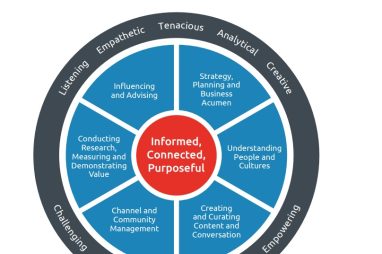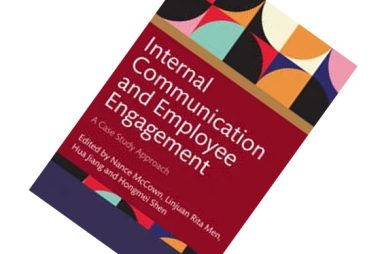Getting ALL aboard the brand train
For those who want to go, that is

About the author
Lindsay-Jane Ackers is a PR and communications professional who submitted this article as part of her CIPR Professional PR Diploma, studying with PR Academy.

Picture the scene. Doug has worked at the same company, a local ‘institution’, for the past twenty years. He has worked his way up to a management position, having started as an apprentice in the manufacturing plant. Doug lives and breathes the company – he knows nearly everyone at work – his family have grown up with him working there.
Suddenly, the company he knows and loves is acquired by a global conglomerate. His job is at risk, the office is filled with new faces, processes, products and cultures. Doug is confused at his position within this new world. His productivity goes down, absence goes up and he feels disengaged – he is far from being aboard the brand train. This is an all too common, yet almost entirely avoidable, situation.
During mergers and acquisitions, the brand and culture of each company is just as important as the financial papers. The integration of brands can make or break a successful takeover, as we saw between Unilever and Kraft Heinz in 2017. It’s said that a ‘clash of culture’ was a key driver in the breakdown of merger conversations.
But if the importance placed on brand is true, why are situations like Doug’s so prevalent? The answer is communication – or a lack of it. Salem presents a myriad of communications behaviours which can contribute to change ‘failure’. The truth is, senior leadership can project all the words of wisdom they like about their own company culture and brand, but if there’s nothing to back this up further down the org chart, it means nothing. If employees like Doug don’t feel the same, that ‘culture’ doesn’t exist, and they aren’t on board with the change.
Three of the quotes that stuck with me were:
“… change of internal organisation and processes and procedures had a major impact on morale. I understand that the cultural change made a few look for other employment.”
“… a friend quit due to the change in the culture of the organisation.”
“… we weren’t sure who we were dealing with – Company X or Company Y.”
These snippets highlight both the internal and external impacts that mergers have on an organisation which should be vital considerations for communications professionals. It presents an important point – which I’ll revisit later – that your employees have a significant influence on the external presentation of a company.
The only way around this is to implement an all-encompassing communications strategy – both internal and external – which ensures that employees are as informed as possible about significant organisational changes such as mergers.
At the time of carrying out my original project, there was a paucity of content on the topic. Fast-forward five years and the wealth of information available makes it clear that organisations, academics and thought leaders are recognising the issue – but we’re still seeing situations like Unilever and Kraft Heinz, so something is still awry.
A key consideration is timing. The majority of literature uses terminology like ‘during’ and ‘post’ merger. That’s too late. Doug’s process of disengagement began when he read about it in the news months ago. Informing team members as early as possible helps them prepare for change, even if they don’t know the full extent. It also helps your external communications efforts – as soon as your news is out there, your customers and suppliers will be asking your staff what’s going on.
This is backed up by Staffbase, who use the following useful visual from Deloitte University Press. They state that communication must outpace change. Whilst the graph is rather expansive, decision makers and strategists could repurpose it in line with their own organisation’s timeline.

Equally as important as timing is content. Numerous studies have shown that employees value transparency more than any other organisational characteristic – this should be viewed as a great PR opportunity, not a challenge.
As far as possible, you should aim to share as much detail as you can with your employees.
Meg Whitman, CEO of Quibi, highlights the importance of communicating solutions as much as you communicate issues. In her article about her work with global IT company, HP, Whitman shares how the internal web channel, HP Next, created an ideal platform to increase transparency during times of change.
As I mentioned before, your employees are a channel to external stakeholders. The more information they have, the more they can share with close customers to avoid the third statement that I mentioned earlier.
Engaged employees are ultimately more empowered to build strong customer relationships, which are critical throughout periods of change.
Tell your story
Remember that Doug (et al) have worked here for the majority of their careers, suggesting that they have an emotional connection to the company. Your content should evoke that emotion, bringing them back in line with the organisation’s goals, objectives and culture. You can use storytelling as a tool to do this.
Gone are the days of the traditional (and now old-fashioned) belief that companies are machines, as Paul Smith testifies in “Lead with a Story.” They are living, breathing bodies which have purpose and narrative. The research behind the use of storytelling as has pushed it to the forefront of business communications strategies around the world.
Storytelling is also a way to gain employee emotional buy-in. This can sound woolly but remember to put yourself in Doug’s shoes. The importance of creating that emotional connection is very often overlooked, yet it is critical to merger success.
There’s a significant amount of research which shows how a positive emotional view towards the workplace can improve employee engagement and productivity. Staw et. al propose a model which shows that positive emotion has desirable effects on individuals, including work achievements, job enrichment and supportive social context. Interestingly, it also points out that people with positive rather than negative emotion are more successful in influencing others. It’s fair to say then, that you can create internal brand ambassadors during mergers and acquisitions to help you tell that brand story and spread the positivity.
Internal Brand Ambassadors
When I talk about brand ambassadors, I’m not talking about external influencers and social media stars which we are too familiar with today. I’m talking about team members who fundamentally believe in the company and who, with their positive emotion, can bring other team members together and get on board the brand train. Doug – pre-acquisition – would have been the perfect brand ambassador – yet the chance was missed because of the lack of communication.
In the Gallup Business Journal, Nate Dvorak and Robert Gabsa state that “when it comes to effective branding, employees wield tremendous power.” Whilst in that particular feature, they are focussed on external branding, I believe that this statement runs true for internal branding, too.
The introduction of internal brand ambassadors means that you can begin to communicate in other ways, branching out from typical hierarchical, topdown communications.
Conversations between colleagues, however informal, are incredibly valuable and the more positive these conversations are, the better the culture will be. Project management software company, Trello, suggests that the typical ‘water cooler’ conversation is evolving to be a platform for collaboration and engagement, rather than just the round up of a weekend.
Brand ambassadors can facilitate the sharing of information in a way that ensures other colleagues can relate to and understand. They can also bridge the perceived gap between leadership and peers – the Edelman Trust Barometer still highlights that peers are measured as more trustworthy than CEOs (although the gap is slowly decreasing).
Kevin Ruck shares Kim & Mauborgne’s idea of ‘tipping point leadership’ which, by its very nature, suggests a situation where a critical mass of a workforce is engaged and on board and change can happen incredibly quickly. Ultimately, this is what your brand ambassadors would be working towards and this is perhaps an overarching, albeit loosely-termed, goal of a change communications strategy.
Two-Way Communications
As far as possible, organisations going through change should allow for two-way communication. Research shows that opening these channels up and giving the people the voice goes a long way in improving employee satisfaction and engagement. Many companies are already finding ways to make this happen, one of the most noted examples being HSBC’s “Shut Up & Listen” campaign.
In an interview with Simply Communicate, Co-Head of HSBC’s Communications, Pierre Goad, reveals that the solution was put in place after acquiring a large number of businesses physically, but not ‘culturally’. This is exactly the same situation as Doug found himself in. An IDG Research study (reported by Appreciation at Work) into the importance of workplace communications shows that managers and leadership are responsible for 57% of engagement (the rest coming from internal motivation). This puts the onus on organisational leadership to get the communications strategy right and allow for a workforce’s voice to be heard.
Whilst two-way communication is undoubtedly a good thing and something that all organisations should strive to have, John Smythe argues that there is such a thing as taking it too far. He suggests that communications strategies of this nature should not be aiming towards a ‘free for all’ democracy or ‘Marxism revisited’ – rather, you should aim to create value through an engaged workforce, which is creative, productive and provides enhanced job satisfaction as a result of your change communication strategy.
You’ll never please everyone
One of the most important lessons that I’ve learned throughout my career and one which I would never hesitate to share with anyone is working through a merger, or any business change, is that you will never please everyone in your organisation.
There will always be individuals who are, as I have affectionately named them, “cave dwellers”. They seem eternally comfortable living and working in the same environment for years on end and reject change any time it comes around.
There is little you can do to change these people’s minds. There are a number of reasons why these people are so resistant to change. Ruck suggests that a number of academics point the finger towards middle management, but also recognises that poor communication in itself is a trigger for disengagement – a point well worth considering when dealing with ‘cave dwellers’.
Josh Hrar, in his blog post on CareerMinds, states that you must appreciate that everyone is different. Indeed, it is the diversity and mix of individuals that makes a company culture what it is. Don MacPherson, Co-Founder and President of Modern Survey even goes as far as to say that “it’s perfectly acceptable to write off employees who will never buy in” – a statement which I believe is slightly aggressive, but emphasises my point nonetheless.
Mergers and acquisitions are just one of a host of changes that an organisation can go through. Each change, in my opinion, is just as important as another one, and it’s vital to remember that different changes impact different employees in different ways.
In any instance, your strategy should aim to get as many people engaged and on board the brand train before it leaves the station – before it’s too late. You shouldn’t stop the train unless absolutely necessary. Hopefully you will welcome Doug and his colleagues on board, but you must remember that some are quite happy being left on the platform.
References
Books
- Smythe, J. 2007. The CEO: Chief Engagement Officer: Turning Hierarchy Upside Down to Drive Performance. Gower. Aldershot. [accessed 25 Sept 2019].
- Ruck, K. 2015. Exploring Internal Communication: Towards Informed Employee Voice. Routledge. Surrey. [accessed 25 Sept 2019].
- Smith, P. 2012. Lead with a Story: A Guide to Crafting Business Narratives that Captivate, Convince and Inspire. AMACOM. New York. [accessed 30 Sept 2019].
Online
- Hrara, J. “Why You Can’t Force Employee Engagement” Career Minds. 2019. Online. [accessed 29 Sep 2019]
- Leimbach, C. “Two-Way Communication: Essential To Employee Engagement” Appreciation at Work. 2015. Online. [Accessed 3 October]
- Wright, M. “HSBC exchanges top down for listening” Simply Communicate. 2014. Online. [accessed 3 October]
- Srivastava, R “Role of Communications in Employee Engagement” People Matters. 2015. Online. [accessed 5 October]
- Edelman Trust Barometer, 2019. Edelman. Online. [accessed 5 October 2019]
- Moon, L. “The Surprising Cognitive Benefits of Small Talk at Work” Trello Blog. 2017. Online. [accessed 8 October]
- Whitman, M. “The Power of Transparent Communication” LinkedIn. 2013. Online. [accessed 8 October]
- Dvorak, N., Gabsa, R. “Failed Brand Ambassadors” Gallup. 2017. Online. [accessed 8 October]
- Engage for Success: Why emotional buy in is critical for employee engagement” 2018. Online. [accessed 9 October]
- Mishra, K., Boynton, L., Mishra, A. “Driving Employee Engagement: The Expanded Role of Internal Communications” International Journal of Business Communications. 2014. 51.
- Donahue, C. “How Business Transparency Empowers Your Company” Business.com. 2019. Online. [accessed 10 October]
- Grover, R. “8 Reasons Why Mobile Internal Communication is More Important Than Ever” Staffbase. 2018. Online. [accessed 10 October]
- Rogers, C. “How to ensure brand identity survives acquisition” Marketing Week. 2017. Online. [accessed 10 October]
- Global Brand Image Management Report – Brand Strategy & Management as a key successfactor within the M&A process. 2017. Online. [accessed 9 October]
- Keegan, P. “The 5 New Rules of Employee Engagement” INC. 2017. Online. [accessed 9 October]
Journals
- Staw et al. Employee Positive Emotion and Favorable Outcomes at the Workplace. Journal of Organisation Science. 5. 1. 1994.


